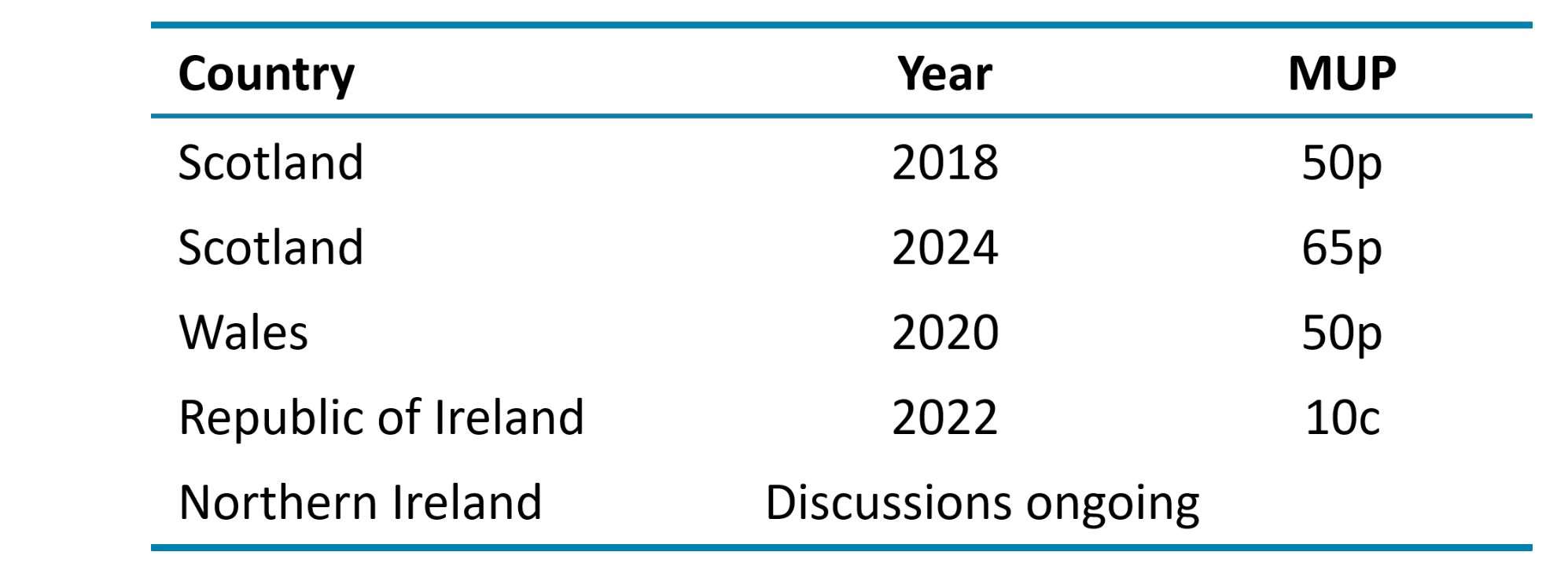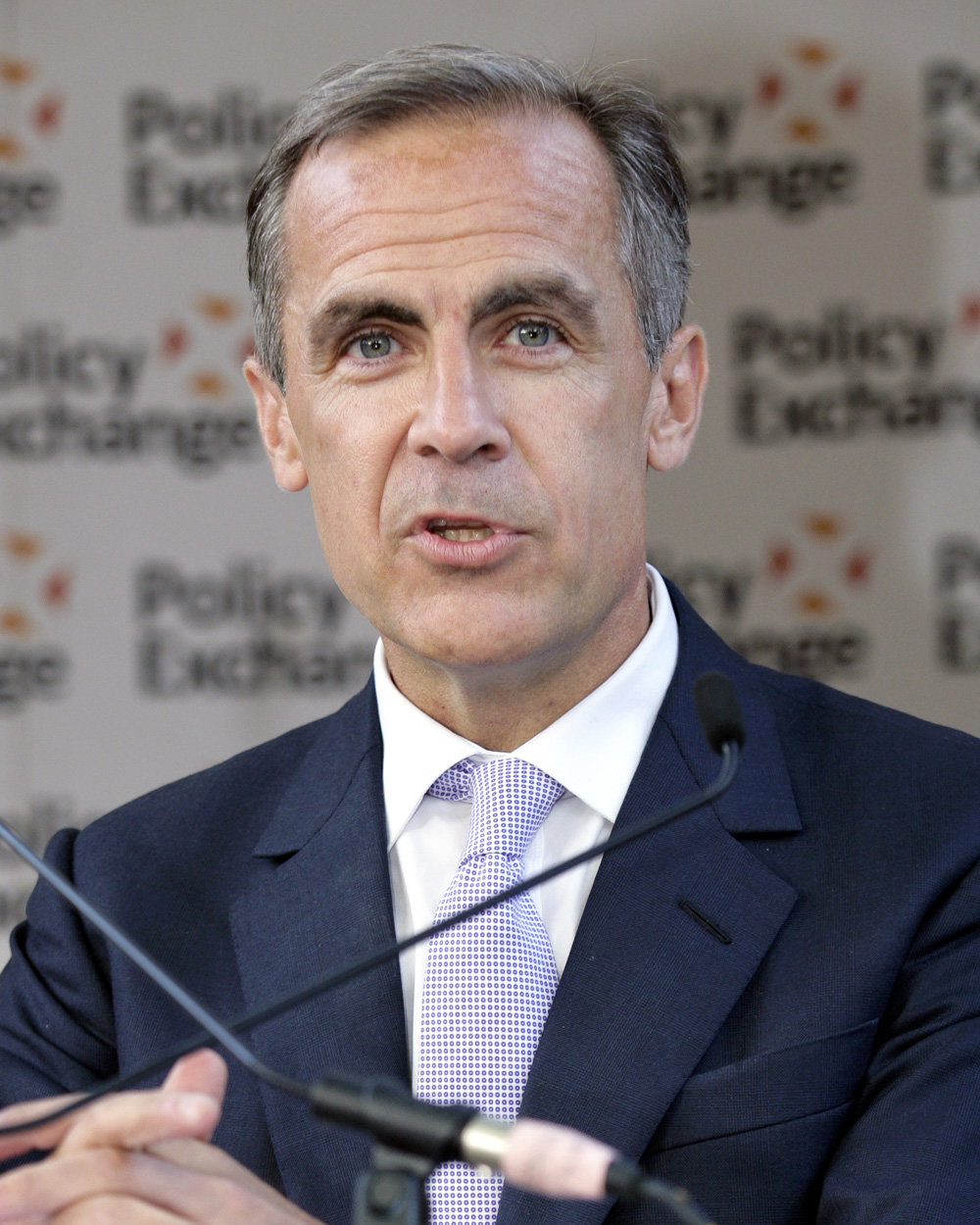 The debate about a minimum price for alcohol continues to be prompted by concerns over high levels of drinking, its effect on public health and public order, and a widespread belief that most of the alcohol that contributes to drunken behaviour is irresponsibly priced and sold. Minimum pricing for alcohol, although considered a radical intervention, is not a new policy. A minimum unit price (MUP) for alcohol was introduced in Scotland in 2018, in Wales in 2020, in the Republic of Ireland in 2022 and looks likely to be introduced in Northern Ireland.
The debate about a minimum price for alcohol continues to be prompted by concerns over high levels of drinking, its effect on public health and public order, and a widespread belief that most of the alcohol that contributes to drunken behaviour is irresponsibly priced and sold. Minimum pricing for alcohol, although considered a radical intervention, is not a new policy. A minimum unit price (MUP) for alcohol was introduced in Scotland in 2018, in Wales in 2020, in the Republic of Ireland in 2022 and looks likely to be introduced in Northern Ireland.
Despite more countries following Scotland’s lead, there are no current plans to consider an application of an MUP in England. However, with recent increases in the MUP in Scotland and the findings of a five-year review in Wales, it would suggest that this policy will continue to be at the forefront of discussions of how to tackle impacts of alcohol consumption.
Reasons and options for intervention
The main goal of introducing a minimum unit price for alcohol is to tackle unwanted consequences from the consumption of alcohol. While many people consume alcoholic drinks safely without any problems, some patterns of alcohol use are associated with significant physical, mental and social harm.
It costs UK society more than £27 billion a year through a combination of health, crime, workplace and social welfare costs. Therefore, some governments in the British Isles have deemed it necessary to intervene in this market to reduce alcohol-related harm and protect the health of those regularly drinking more than the recommended 14 units per week.
 Research has shown that making alcohol less affordable can reduce consumption and hence related harms. The World Health Organization considers minimum pricing one of its ‘best buys’ for tackling harmful alcohol use.
Research has shown that making alcohol less affordable can reduce consumption and hence related harms. The World Health Organization considers minimum pricing one of its ‘best buys’ for tackling harmful alcohol use.
There are three main policy options that aim to reduce the consumption of alcohol by making alcohol less affordable. One is to tax alcoholic drinks; the second is to set a minimum price per unit of alcohol; the third is to ban the sale of alcohol drinks below cost price (the level of alcohol duty plus VAT).
The policy option of an MUP has been adopted by Scotland, Wales and the Republic of Ireland; England has opted to use a ban on selling alcohol below the level of alcohol duty plus VAT (since 28 May 2014).
What is a minimum price?
The introduction by the government of a minimum price for a product means that it cannot legally be sold below that price. It can be set in order to achieve certain economic or social objectives that are not currently being achieved at equilibrium in the market. In order for the policy to have an effect, the minimum price must be set above the equilibrium price. This price floor then prevents prices from falling too low and settling back at equilibrium below the MUP.
A common misconception is that introducing a minimum price for alcohol is a form of taxation. However, this is not the case. Implementing an MUP means that any extra money from higher prices goes to the retailers and producers, not to the government.
Why choose a minimum price floor?
The policy has two main objectives. The first is to protect the interests of drinkers who may make poor decisions on their own behalf. This may be from lack of information, social pressures or a disregard for their own long-term health or welfare.
The second objective is to reduce the external costs placed on health services, the police, the criminal justice system, on fellow citizens or employers. There are also longer-term external costs when alcohol abuse impacts on productivity or leads to repeated absences from work.
It is argued that MUP intervention can encourage positive changes in behaviour of both consumers and producers. It can target harmful excessive drinking, while leaving the more moderate drinker relatively unaffected.
 A positive impact on consumers is the possible changes in demand. People who previously consumed cheap, and often strong, drinks, such as cheap cider, will find that their marginal private cost of consuming alcohol has increased. Depending on the price elasticity of demand, their consumption will decrease and there will be a reduction in alcohol-related violence and other external costs. A positive impact on producers is that it can encourage drinks manufacturers themselves to reduce the alcohol content of their products and, therefore, limit any increase in price passed on to the consumer.
A positive impact on consumers is the possible changes in demand. People who previously consumed cheap, and often strong, drinks, such as cheap cider, will find that their marginal private cost of consuming alcohol has increased. Depending on the price elasticity of demand, their consumption will decrease and there will be a reduction in alcohol-related violence and other external costs. A positive impact on producers is that it can encourage drinks manufacturers themselves to reduce the alcohol content of their products and, therefore, limit any increase in price passed on to the consumer.
How it differs in the different parts of the British Isles
While minimum alcohol pricing is in place in several countries, policies differ. In terms of the British Isles, in 2018 Scotland became the first country to introduce a national minimum price for all types of alcohol. Two years later, Wales followed suit. The Republic of Ireland introduced minimum pricing in January 2022, while Northern Ireland has been engaged in consultation on the policy for several years. The following table shows when MUP was introduced and at what rates.

Has the MUP been effective?
Wales has reached the five-year review point since the MUP was introduced. Many of the findings within the Welsh evaluation have strong resonance with those elsewhere, particularly those of the final Scottish evaluation. There have been five main findings:
- Implementation has been smooth. Retailers have largely complied with the law, and enforcement has been effective.
- Certain cheap alcohol products have disappeared. Large bottles of strong cider, for example, are now rare. There have also been shifts in promotions and product availability.
- There are indications that overall alcohol consumption in Wales has declined. While it is difficult to measure directly, purchasing data suggests a reduction.
- Concerns about unintended consequences have not materialised significantly. Predictions of a rise in home brewing, substance switching, shoplifting and cross-border purchasing have not been widely observed.
- Some drinkers have changed their purchasing habits. A minority have switched from cider to wine or spirits as price differences narrowed. Others, particularly those on low incomes, experienced further struggles in financially maintaining their drinking habits.
There was also a study published last year (2024) in the journal Economic Inquiry, looking at the impacts of the policy during lockdown restrictions. The study showed that the introduction of MUP in Wales resulted in a 15% increase in transaction prices and a sharp reduction in the amount of alcohol bought, around 20%, with an overall drop in expenditure per customer compared to England over the same period.
However, it should be noted that the COVID pandemic disrupted drinking habits and the availability of alcohol. In addition, evaluating the overall effects of the policy has been complex with other economic factors, including the cost-of-living crisis, also influencing affordability.
Is it a fair policy?
A counter argument to applying a price intervention on alcohol is that it may have unintended private and external costs. One argument claims that young people could decide to switch to cheaper non-alcoholic drugs instead. Alternatively, they may seek to purchase alcohol on illegal shadow markets.
 Critics of the policy argue that it negatively impacts those who consume alcohol responsibly, especially families on average or below-average incomes. The wine and spirits industry tried to lobby against the Scottish government, arguing that it is inconsistent with the operation of the free market and that the intervention creates a barrier to trade. They claim that lower sales of alcoholic drinks will cost jobs in the UK, both in manufacturing and from reduced revenues of corner shops, pubs and other retailers.
Critics of the policy argue that it negatively impacts those who consume alcohol responsibly, especially families on average or below-average incomes. The wine and spirits industry tried to lobby against the Scottish government, arguing that it is inconsistent with the operation of the free market and that the intervention creates a barrier to trade. They claim that lower sales of alcoholic drinks will cost jobs in the UK, both in manufacturing and from reduced revenues of corner shops, pubs and other retailers.
There is also an argument that relying solely on an MUP targets the affordability of drinking rather than addressing all aspects of alcohol harm. Therefore, this policy is not necessarily effective in achieving all the government’s goals. Critics argue that this policy should be one component of a more comprehensive strategy delivery, which might include education, restricting the availability of alcohol, banning advertising, increasing alcohol duty, etc.
Conclusion
Although there are currently no plans to implement an MUP in England, there is ongoing pressure for the Government to consider adopting one. In the Autumn of 2024, Lord Darzi carried out an independent investigation of the NHS in England. This investigation into the NHS highlighted the ‘alarming’ death toll in England caused by cheap drink (see link below). This led public health leaders to call for action to increase the price of cheap alcohol in supermarkets and off-licences.
 However, the policy itself is not without its critics, especially those citing continued trends in actual numbers of alcohol-related deaths. Therefore, it is suggested that the policy needs to be accompanied by well-funded treatment and support services for people experiencing alcohol-related difficulties. If combined with other policy measures and social support, it has the potential to contribute significantly to reductions in alcohol-related harm.
However, the policy itself is not without its critics, especially those citing continued trends in actual numbers of alcohol-related deaths. Therefore, it is suggested that the policy needs to be accompanied by well-funded treatment and support services for people experiencing alcohol-related difficulties. If combined with other policy measures and social support, it has the potential to contribute significantly to reductions in alcohol-related harm.
Despite reservations, overall a minimum price per unit of alcohol is viewed by many as a justified intervention and is well supported by evidence. It has been accepted that a minimum price is required to reduce consumption closer towards the social optimum and in order to bring about change in consumer and producer behaviour. Given the evidence provided from current MUP countries and ongoing discussions of alcohol-related deaths in England, health officials believe a review is almost certain, even though the current government reportedly ruled out minimum unit pricing shortly after winning power.
Articles
Reports
Questions
- Using a supply and demand diagram, discuss the effect of introducing a minimum price per unit of alcohol.
- How is the price elasticity of demand for alcoholic drinks relevant to determining the success of minimum pricing?
- Compare the effects on alcohol consumption of imposing a minimum unit price of alcohol with a ban the sale of alcohol below cost price. What are the revenue implications of the two policies for the government?
- What negative externalities occur as a result in the over consumption of alcohol? How could a socially efficient price for alcohol be determined?
- Could alcohol consumption be described as a ‘de-merit good’? Explain.
- Rather than targeting the price of alcohol, what other policies could the government introduce to tackle over consumption of alcohol?
- What will determine the number of people travelling across borders within the UK (i.e. from Scotland or Wales to England) to buy cheaper alcoholic drinks?

Politicians, business leaders, climate scientists, interest groups and journalists from across the world have been meeting in Dubai at the COP28 climate summit (the 28th annual meeting of the Conference of the Parties (COP) to the United Nations Framework Convention on Climate Change (UNFCCC)). The meeting comes at a time when various climate tipping points are being reached or approached – some bad, but some good. Understanding these tipping points and their implications for society and policy requires understanding not only the science, but also the various economic incentives affecting individuals, businesses, politicians and societies.
Tipping points
A recent report (see first reference in articles section below) identified various climate tipping points. These are when global temperatures rise to a point where various domino effects occur. These are adverse changes to the environment that gather pace and have major effects on ecosystems and the ability to grow food and support populations. These, in turn, will have large effects on economies, migration and political stability.
 According to the report, five tipping points are imminent with the current degree of global warming (1.2oC). These are:
According to the report, five tipping points are imminent with the current degree of global warming (1.2oC). These are:
- Melting of the Greenland ice sheet;
- Melting of the West Antarctic ice sheet;
- Death of warm-water coral reefs;
- Collapse of the North Atlantic Subpolar Gyre circulation, which helps to drive the warm current that benefits Western Europe;
- Widespread rapid thawing of permafrost, where tundra without snow cover rapidly absorbs heat and releases methane (a much more powerful source of global warming than CO2).
With global warming of 1.5oC, three more tipping points are likely: the destruction of seagrass meadows, mangrove swamps and the southern part of the boreal forests that cover much of northern Eurasia. As the temperature warms further, other tipping points can interact in ways that drive one another, resulting in tipping ‘cascades’.
But the report also strikes an optimistic note, arguing that positive tipping points are also possible, which will help to slow global warming in the near future and possibly reverse it further in the future.

The most obvious one is in renewable energy. Renewable power generation in many countries is now cheaper than generation from fossil fuels. Indeed, in 2022, over 80% of new electricity generation was from solar and wind. And as it becomes cheaper, so this will drive investment in new renewable plants, including in small-scale production suitable for use in developing countries in parts not connected to a grid. In the vehicle sector, improved battery technology, the growth in charging infrastructure and cheaper renewable sources of electricity are creating a tipping point in EV take-up.
Positive tipping points can take place as a result of changing attitudes, such as moving away from a meat-intensive diet, avoiding food waste, greater use of recycling and a growth in second-hand markets.
But these positive tipping points are so far not strong enough or quick enough. Part of the problem is with economic incentives in market systems and part is with political systems.
Market failures
Economic decisions around the world of both individuals and firms are made largely within a market environment. But the market fails to take into account the full climate costs and benefits of such decisions. There are various reasons why.
Externalities. Both the production and consumption of many goods, especially energy and transport, but also much of agriculture and manufacturing, involve the production of CO2. But the costs of the resulting global warming are not born directly by the producer or consumer. Instead they are external costs born by society worldwide – with some countries and individuals bearing a higher cost than others. The result is an overproduction or consumption of such goods from the point of view of the world.
 The environment as a common resource. The air, the seas and many other parts of the environment are not privately owned. They are a global ‘commons’. As such, it is extremely difficult to exclude non-payers from consuming the benefits they provide. Because of this property of ‘non-excludability’, it is often possible to consume the benefits of the environment at a zero price. If the price of any good or service to the user is zero, there is no incentive to economise on its use. In the case of the atmosphere as a ‘dump’ for greenhouse gases, this results in its overuse. Many parts of the environment, however, including the atmosphere, are scarce: there is rivalry in their use. As people increase their use of the atmosphere as a dump for carbon, so the resulting global warming adversely affects the lives of others. This is an example of the tragedy of the commons – where a free resource (such as common land) is overused.
The environment as a common resource. The air, the seas and many other parts of the environment are not privately owned. They are a global ‘commons’. As such, it is extremely difficult to exclude non-payers from consuming the benefits they provide. Because of this property of ‘non-excludability’, it is often possible to consume the benefits of the environment at a zero price. If the price of any good or service to the user is zero, there is no incentive to economise on its use. In the case of the atmosphere as a ‘dump’ for greenhouse gases, this results in its overuse. Many parts of the environment, however, including the atmosphere, are scarce: there is rivalry in their use. As people increase their use of the atmosphere as a dump for carbon, so the resulting global warming adversely affects the lives of others. This is an example of the tragedy of the commons – where a free resource (such as common land) is overused.
Inter-generational problems. The effect of the growth in carbon emissions is long term, whereas the benefits are immediate. Thus consumers and firms are frequently prepared to continue with various practices, such as driving, flying and using fossil fuels for production, and leave future generations to worry about their environmental consequences. The problem, then, is a reflection of the importance that people attach to the present relative to the future.
Ignorance. People may be contributing to global warming without realising it. They may be unaware of which of the goods they buy involve the release of carbon in their production or how much carbon they release when consumed.
Political failures
Governments, whether democratic or dictatorships, face incentives not to reduce carbon emissions – or to minimise their reduction, especially if they are oil producing countries. Reducing carbon involves short-term costs to consumers and this can make them unpopular. It could cost them the next election or, in the case of dictatorships, make them vulnerable to overthrow. What is more, the oil, coal and gas industries have a vested interest in continuing the use of fossil fuels. Such industries wield considerable political power.
 Even if governments want the world to reduce carbon emissions, they would rather that the cost of doing so is born less by their own country and more by other countries. This creates a prisoner’s dilemma, where the optimum may be for a large global reduction in carbon emissions, but the optimum is not achieved because countries individually are only prepared to reduce a little, expecting other countries to reduce more. Getting a deal that is deemed ‘fair’ by all countries is very difficult. An example is where developing countries, may feel that it is fair that the bulk of any cuts, if not all of them, should be made by developed countries, while developed countries feel that fixed percentage cuts should be made by all countries.
Even if governments want the world to reduce carbon emissions, they would rather that the cost of doing so is born less by their own country and more by other countries. This creates a prisoner’s dilemma, where the optimum may be for a large global reduction in carbon emissions, but the optimum is not achieved because countries individually are only prepared to reduce a little, expecting other countries to reduce more. Getting a deal that is deemed ‘fair’ by all countries is very difficult. An example is where developing countries, may feel that it is fair that the bulk of any cuts, if not all of them, should be made by developed countries, while developed countries feel that fixed percentage cuts should be made by all countries.
Policy options
If the goal is to tackle climate change, then the means is to reduce the amount of carbon in the atmosphere (or at the least to stop its increase – the net zero target). There are two possibilities here. The first is to reduce the amount of carbon emissions. The second is to use carbon capture and storage or carbon sequestration (e.g. through increased forestation).
 In terms of reducing carbon emissions, the key is reducing the consumption of carbon-producing activities and products that involve emissions in their production. This can be achieved through taxes on such products and/or subsidies on green alternatives (see the blog ‘Are carbon taxes a solution to the climate emergency?‘). Alternatively carbon-intensive consumption can be banned or phased out by law. For example, the purchase of new petrol or diesel cars cold be banned beyond a certain date. Or some combination of taxation and regulation can be used, such as in a cap-and-trade system – for example, the EU Emissions Trading System (EU ETS) (see the blog ‘Carbon pricing in the UK‘). Then there is government investment in zero carbon technologies and infrastructure (e.g. electrifying railways). In practice, a range of policy instruments are needed (see the blog ‘Tackling climate change: “Everything, everywhere, all at once”‘).
In terms of reducing carbon emissions, the key is reducing the consumption of carbon-producing activities and products that involve emissions in their production. This can be achieved through taxes on such products and/or subsidies on green alternatives (see the blog ‘Are carbon taxes a solution to the climate emergency?‘). Alternatively carbon-intensive consumption can be banned or phased out by law. For example, the purchase of new petrol or diesel cars cold be banned beyond a certain date. Or some combination of taxation and regulation can be used, such as in a cap-and-trade system – for example, the EU Emissions Trading System (EU ETS) (see the blog ‘Carbon pricing in the UK‘). Then there is government investment in zero carbon technologies and infrastructure (e.g. electrifying railways). In practice, a range of policy instruments are needed (see the blog ‘Tackling climate change: “Everything, everywhere, all at once”‘).
With carbon capture, again, solutions can involve a mixture of market mechanisms and regulation. Market mechanisms include subsidies for using carbon capture systems or for afforestation. Regulation includes policies such as requiring filters to be installed on chimneys or banning the felling of forests for grazing land.
The main issue with such policies is persuading governments to adopt them. As we saw above, governments may be unwilling to bear the short-term costs to consumers and the resulting loss in popularity. Winning the next election or simple political survival may be their number-one priority.
COP28
The COP28 summit concluded with a draft agreement which called for the:
transitioning away from fossil fuels in energy systems, in a just, orderly and equitable manner, accelerating action in this critical decade, so as to achieve net zero by 2050 in keeping with the science.
This was the first COP summit that called on all nations to transition away from fossil fuels for energy generation. It was thus hailed as the biggest step forward on tackling climate change since the 2015 Paris agreement. However, there was no explicit commitment to phase out or even ‘phase down’ fossil fuels. Many scientists, climate interest groups and even governments had called for such a commitment. What is more, there was no agreement to transition away from fossil fuels for transport, agriculture or the production of plastics.
If the agreement is to be anything more than words, the commitment must now be translated into specific policy actions by governments. This is where the real test will come. It’s easy to make commitments; it’s much harder to put them into practice with policy measures that are bound to impose costs on various groups of people. What is more, there are powerful lobbies, such as the oil, coal and steel industries, which want to slow any transition away from fossil fuels – and many governments of oil producing countries which gain substantial revenues from oil production.
One test will come in two years’ time at the COP30 summit in the Amazonian city of Belém, Brazil. At that summit, countries must present new nationally determined commitments that are economy-wide, cover all greenhouse gases and are fully aligned with the 1.5°C temperature limit. This will require specific targets to be announced and the measures required to achieve them. Also, it is hoped that by then there will be an agreement to phase out fossil fuels and not just to ‘transition away’ from them.
Reasons for hope
 Despite the unwillingness of many countries, especially the oil and coal producing countries, to phase out fossil fuels, there are reasons for hope that global warming may be halted and eventually even reversed. Damage will have been done and some tipping points may have been reached, but further tipping points may be averted.
Despite the unwillingness of many countries, especially the oil and coal producing countries, to phase out fossil fuels, there are reasons for hope that global warming may be halted and eventually even reversed. Damage will have been done and some tipping points may have been reached, but further tipping points may be averted.
The first reason is technological advance. Research, development and investment in zero carbon technologies is advancing rapidly. As we have seen, power generation from wind and solar is now cheaper than from fossil fuels. And this cost difference is likely to grow as technology advances further. This positive tipping point is becoming more rapid. Other technological advances in transport and industry will further the shift towards renewables and other advances will economise on the use of power.
The second is changing attitudes. With the environment being increasingly included in educational syllabuses around the world and with greater stress on the problems of climate change in the media, with frequent items in the news and with programmes such as the three series of Planet Earth, people are becoming more aware of the implications of climate change and how their actions contribute towards the problem. People are likely to put increasing pressure on businesses and governments to take action. Growing awareness of the environmental impact of their actions is also affecting people’s choices. The negative externalities are thus being reduced and may even become positive ones.
Articles
- Global Tipping Points
University of Exeter, Global Systems Institute, Timothy M. Lenton et al. (6/12/23)
- Report: Pivotal moment for humanity as tipping point threats and opportunities accelerate
Phys.org (6/12/23)
- Earth is closing in on catastrophic climate ‘tipping points’, over 200 scientists warn
Independent, Vishwam Sankaran (6/12/23)
- Earth on verge of five catastrophic climate tipping points, scientists warn
The Guardian, Ajit Niranjan (6/12/23)
- Cop28: King Charles warns of ‘vast, frightening experiment’ on natural world
The Guardian, Fiona Harvey, Nina Lakhani, Aletha Adu, Damian Carrington, Patrick Greenfield and Oliver Milman (1/12/23)
- UK likely to miss Paris climate targets by wide margin, analysis shows
The Guardian, Fiona Harvey (5/12/23)
- Water and the High Price of Bad Economics
Project Syndicate, Mariana Mazzucato , Partha Dasgupta, Nicholas Stern, and Johan Rockström (1/12/23)
- Fossil fuels: Can humanity really kick its addiction?
BBC News, Justin Rowlatt (10/12/23)
- Five climate change solutions under the spotlight at COP28
BBC News, Mark Poynting (6/12/23)
- COP28: Five reasons for optimism on climate
BBC News, Matt McGrath (8/12/23)
- COP28 Agreement Signals “Beginning of the End” of the Fossil Fuel Era
UN Climate Press Release (13/12/23)
- COP28 climate summit ends with deal to transition away from fossil fuels
CNBC, Ruxandra Iordache and Sam Meredith (13/12/23)
- Cop28 landmark deal agreed to ‘transition away’ from fossil fuels
The Guardian, Adam Morton, Fiona Harvey and Patrick Greenfield (13/12/23)
- COP28 draft agreement drops phaseout of fossil fuels
Financial Times, Attracta Mooney, Aime Williams and Alice Hancock (13/12/23)
- Examining COP28’s potential impact on climate change
BBC News, Matt McGrath (13/12/23)
- Cop28 failed to halt fossil fuels’ deadly expansion plans – so what now?
The Guardian, Damian Carrington (14/12/23)
- The momentum of the solar energy transition
Nature Communications, Femke Nijsse, Jean-Francois Mercure, Nadia Ameli, Francesca Larosa, Sumit Kothari, Jamie Rickman, Pim Vercoulen and Hector Pollitt (17/10/23)
 COP28: Bill Gates on climate optimism, wealth and the human condition
COP28: Bill Gates on climate optimism, wealth and the human conditionBBC News on YouTube, Bill Gates (2/12/23)
- From the Paris agreement to COP28, how oil and gas giants try to influence the global climate agenda
The Conversation, Alain Naef (8/12/23)
- COP28: Phasedown or Phaseout, Fossil Fuels Must be Addressed to Meet 1.5C Goal
Forbes, Felicia Jackson (5/12/23)
Questions
- Use a diagram to demonstrate the effects of negative externalities in production on the level of output and how this differs from the optimum level.
- Use another diagram to demonstrate the effects of negative externalities in consumption on the level of consumption and how this differs from the optimum level.
- What was agreed at COP28?
- What incentives were included in the agreement to ensure countries stick to the agreement? Were they likely to be sufficient?
- What can governments do to encourage positive environmental tipping points?
- How may carbon taxes be used to tackle global warming? Are they an efficient policy instrument?
- What can be done to change people’s attitudes towards their own carbon emissions?
 The UN’s Intergovernmental Panel on Climate Change (IPCC) has just published the first part of its latest seven-yearly Assessment Report (AR6) on global warming and its consequences (see video summary). The report was prepared by 234 scientists from 66 countries and endorsed by 195 governments. Its forecasts are stark. World temperatures, already 1.1C above pre-industrial levels, will continue to rise. This will bring further rises in sea levels and more extreme weather conditions with more droughts, floods, wildfires, hurricanes and glacial melting.
The UN’s Intergovernmental Panel on Climate Change (IPCC) has just published the first part of its latest seven-yearly Assessment Report (AR6) on global warming and its consequences (see video summary). The report was prepared by 234 scientists from 66 countries and endorsed by 195 governments. Its forecasts are stark. World temperatures, already 1.1C above pre-industrial levels, will continue to rise. This will bring further rises in sea levels and more extreme weather conditions with more droughts, floods, wildfires, hurricanes and glacial melting.
The IPCC looked at a number of scenarios with different levels of greenhouse gas emissions. Even in the most optimistic scenarios, where significant steps are taken to cut emissions, global warming is set to reach 1.5C by 2040. If few or no cuts are made, global warming is predicted to reach 4.4C by 2080, the effects of which would be catastrophic.
 The articles below go into considerable detail on the different scenarios and their consequences. Here we focus on the economic causes of the crisis and the policies that need to be pursued.
The articles below go into considerable detail on the different scenarios and their consequences. Here we focus on the economic causes of the crisis and the policies that need to be pursued.
Global success in reducing emissions, although partly dependent on technological developments and their impact on costs, will depend largely on the will of individuals, firms and governments to take action. These actions will be influenced by incentives, economic, social and political.
Economic causes of the climate emergency
The allocation of resources across the world is through a mixture of the market and government intervention, with the mix varying from country to country. But both market and government allocation suffer from a failure to meet social and environmental objectives – and such objectives change over time with the preferences of citizens and with the development of scientific knowledge.
 The market fails to achieve a socially efficient use of the environment because large parts of the environment are a common resource (such as the air and the oceans), because production or consumption often generates environmental externalities, because of ignorance of the environmental effects of our actions, and because of a lack of concern for future generations.
The market fails to achieve a socially efficient use of the environment because large parts of the environment are a common resource (such as the air and the oceans), because production or consumption often generates environmental externalities, because of ignorance of the environmental effects of our actions, and because of a lack of concern for future generations.
Governments fail because of the dominance of short-term objectives, such as winning the next election or appeasing a population which itself has short-term objectives related to the volume of current consumption. Governments are often reluctant to ask people to make sacrifices today for the future – a future when there will be a different government. What is more, government action on the environment which involves sacrifices from their own population, often primarily benefit people in other countries and/or future generations. This makes it harder for governments to get popular backing for such policies.
Economic systems are sub-optimal when there are perverse incentives, such as advertising persuading people to consume more despite its effects on the environment, or subsidies for industries producing negative environmental externalities. But if people can see the effects of global warming affecting their lives today, though fires, floods, droughts, hurricanes, rising sea levels, etc., they are more likely to be willing to take action today or for their governments to do so, even if it involves various sacrifices. Scientists, teachers, journalists and politicians can help to drive changes in public opinion through education and appealing to people’s concern for others and for future generations, including their own descendants.
Policy implications of the IPCC report
 At the COP26 meeting in Glasgow in November, countries will gather to make commitments to tackle climate change. The IPCC report is clear: although we are on course for a 1.5C rise in global temperatures by 2040, it is not too late to take action to prevent rises going much higher: to avoid the attendant damage to the planet and changes to weather systems, and the accompanying costs to lives and livelihoods. Carbon neutrality must be reached as soon as possible and this requires strong action now. It is not enough for government to set dates for achieving carbon neutrality, they must adopt policies that immediately begin reducing emissions.
At the COP26 meeting in Glasgow in November, countries will gather to make commitments to tackle climate change. The IPCC report is clear: although we are on course for a 1.5C rise in global temperatures by 2040, it is not too late to take action to prevent rises going much higher: to avoid the attendant damage to the planet and changes to weather systems, and the accompanying costs to lives and livelihoods. Carbon neutrality must be reached as soon as possible and this requires strong action now. It is not enough for government to set dates for achieving carbon neutrality, they must adopt policies that immediately begin reducing emissions.
The articles look at various policies that governments can adopt. They also look at actions that can be taken by people and businesses, actions that can be stimulated by government incentives and by social pressures. Examples include:
- A rapid phasing out of fossil fuel power stations. This may require legislation and/or the use of taxes on fossil fuel generation and subsidies for green energy.
- A rapid move to green transport, with investment in charging infrastructure for electric cars, subsidies for electric cars, a ban on new petrol and diesel vehicles in the near future, investment in hydrogen fuel cell technology for lorries and hydrogen production and infrastructure, cycle lanes and various incentives to cycle.
- A rapid shift away from gas for cooking and heating homes and workplaces and a move to ground source heating, solar panels and efficient electric heating combined with battery storage using electricity during the night. These again may require a mix of investment, legislation, taxes and subsidies.
- Improvements in energy efficiency, with better insulation of homes and workplaces.
- Education, public information and discussion in the media and with friends on ways in which people can reduce their carbon emissions. Things we can do include walking and cycling more, getting an electric car and reducing flying, eating less meat and dairy, reducing food waste, stopping using peat as compost, reducing heating in the home and putting on more clothes, installing better insulation and draught proofing, buying more second-hand products, repairing products where possible rather than replacing them, and so on.
- Governments requiring businesses to conduct and publish green audits and providing a range of incentives and regulations for businesses to reduce carbon emissions.
It is easy for governments to produce plans and to make long-term commitments that will fall on future governments to deliver. What is important is that radical measures are taken now. The problem is that governments are likely to face resistance from their supporters and from members of the public and various business who resist facing higher costs now. It is thus important that the pressures on governments to make radical and speedy reductions in emissions are greater than the pressures to do little or nothing and that governments are held to account for their actions and that their actions match their rhetoric.
Articles
 Some climate changes now irreversible, says stark UN report
Some climate changes now irreversible, says stark UN reportChannel 4 News, Alex Thomson (9/8/21)
- Climate change: IPCC report is ‘code red for humanity’
BBC News, Matt McGrath (10/8/21)
- Climate change: Five things we have learned from the IPCC report
BBC News, Matt McGrath (10/8/21)
- Climate Scientists Reach ‘Unequivocal’ Consensus on Human-Made Warming in Landmark Report
Bloomberg Green, Eric Roston and Akshat Rathi (9/8/21)
- Climate change: Seven key takeaways from the IPCC climate change report
Sky News, Philip Whiteside (10/8/21)
- IPCC report: global emissions must peak by 2025 to keep warming at 1.5°C – we need deeds not words
The Conversation, Keith Baker (9/8/21)
- This is the most sobering report card yet on climate change and Earth’s future. Here’s what you need to know
The Conversation, Pep Canadell, Joelle Gergis, Malte Meinshausen, Mark Hemer and Michael Grose (9/8/21)
- IPCC report: how to make global emissions peak and fall – and what’s stopping us
The Conversation, Matthew Paterson (9/8/21)
- World’s 1.5C goal slipping beyond reach without urgent action, warns landmark IPCC climate report
Independent, Daisy Dunne and Louise Boyle (9/8/21)
- IPCC report: 14 ways to fight the climate crisis after publication of ‘Code Red’ warning
Independent, Harry Cockburn (10/8/21)
- Major climate changes inevitable and irreversible – IPCC’s starkest warning yet
The Guardian, Fiona Harvey (9/8/21)
- Climate scientists have done their bit. Now the pressure is on leaders for COP26.
CNN, Ivana Kottasová and Angela Dewan (10/8/21)
- 21 For 21: The Climate Change Actions Scotland Needs Now
Common Weal, Common Weal Energy Policy Group (9/8/21)
- How to build support for ambitious climate action in 4 steps
The Conversation, Sarah Sharma and Matthew Hoffmann (4/3/21)
- Scientists have finally added world politics to their climate models
Quartz, Michael J Coren (9/8/21)
Report
Questions
- Summarise the effects of different levels of global warming as predicted by the IPCC report.
- To what extent is global warming an example of the ‘tragedy of the commons’?
- How could prices be affected by government policy so as to provide an incentive to reduce carbon emissions?
- What incentives could be put in place to encourage people to cut their own individual carbon footprint?
- To what extent is game theory relevant to understanding the difficulties of achieving international action on reducing carbon emissions?
- Identify four different measures that a government could adopt to reduce carbon emissions and assess the likely effectiveness of these measures.
 Each year the BBC hosts the Reith Lectures – a series of talks given by an eminent person in their field. This year’s lecturer is Mark Carney, former Governor of the Bank of England. His series of four weekly lectures began on 2 December 2020. Their topic is ‘How we get what we value’. As the BBC site states, the lectures:
Each year the BBC hosts the Reith Lectures – a series of talks given by an eminent person in their field. This year’s lecturer is Mark Carney, former Governor of the Bank of England. His series of four weekly lectures began on 2 December 2020. Their topic is ‘How we get what we value’. As the BBC site states, the lectures:
chart how we have come to esteem financial value over human value and how we have gone from market economies to market societies. He argues that this has contributed to a trio of crises: of credit, Covid and climate. And the former Bank of England governor will outline how we can turn this around.
 In lectures 2, 3 and 4, he looks at three crises and how they have shaped and are shaping what we value. The crises are the financial crisis of 2007–9, the coronavirus pandemic and the climate crisis. They have challenged how we value money, health and the environment respectively and, more broadly, have prompted people to question what is valuable for individuals and society, both today and into the future.
In lectures 2, 3 and 4, he looks at three crises and how they have shaped and are shaping what we value. The crises are the financial crisis of 2007–9, the coronavirus pandemic and the climate crisis. They have challenged how we value money, health and the environment respectively and, more broadly, have prompted people to question what is valuable for individuals and society, both today and into the future.
The questions posed by Carney are how can we establish what is valuable to individuals and society, how well are such values met by economies and how can mechanisms be improved to ensure that we make the best use of resources in meeting those values.
Value and the market
In the first lecture he probes the concept of value. He explores how economists and philosophers have tried to value the goods, services and human interactions that we desire.
First there is ‘objective value’ propounded by classical economists, such as Adam smith, David Ricardo and Karl Marx. Here the value of goods and services depends on the amount of resources used to make them and fundamentally on the amount of labour. In other words, value is a supply-side concept.
This he contrasts with ‘subjective value’. Here the value of goods and services depends on how well they satisfy wants – how much utility they give the consumer. For these neoclassical economists, value is in the eye of the beholder; it is a demand-side concept.
The two are reconciled in the market, with market prices reflecting the balance of demand and supply. Market prices provided a solution to the famous diamonds/water paradox (see Box 4.2 in Economics (10th edition) or Case Study 4.3 in Essentials of Economics (8th edition) – the paradox of ‘why water, which is essential for life, is virtually free, but diamonds, which have limited utility beyond their beauty, are so expensive.’ The answer is to do with scarcity and marginal utility. Because diamonds are rare, the marginal utility is high, even though the total utility is low.  And because water is abundant, even though its total utility is high, for most people its marginal utility is low. In other words, the value at the margin depends on the balance of demand and supply. Diamonds are much scarcer than water.
And because water is abundant, even though its total utility is high, for most people its marginal utility is low. In other words, the value at the margin depends on the balance of demand and supply. Diamonds are much scarcer than water.
But is the market balance the right balance? Are the values implied by the market the same as those of society? ‘Why do financial markets rate Amazon as one of the world’s most valuable companies, but the value of the vast region of the Amazon appears on no ledger until it’s stripped of its foliage and converted into farmland?’ – another paradox highlighted by Carney.
It has long been recognised that markets fail in a number of ways. They are not perfect, with large firms able to make supernormal profits by charging more and producing less, and consumers often being ill-informed and behaving impulsively or being swayed by clever marketing. And many valuable things that we experience, such as human interaction and the beauty of nature, are not bought and sold and thus do not appear in measures of GDP – one of the main ways of valuing a country.
 What is more, many of things that are produced in the market have side-effects which are not reflected in prices. These externalities, whether good or bad, can be substantial: for example, the global warming caused by CO2 emissions from industry, transport and electricity production from fossil fuels.
What is more, many of things that are produced in the market have side-effects which are not reflected in prices. These externalities, whether good or bad, can be substantial: for example, the global warming caused by CO2 emissions from industry, transport and electricity production from fossil fuels.
And markets reflect people’s biases towards the present and hence lead to too little investment for the future, whether in healthcare, the environment or physical and social infrastructure. Markets reflect the scant regard many give to the damage we might be doing to the lives of future generations.
What is particularly corrosive, according to Carney, is the
drift from moral to market sentiments. …Increasingly, the value of something, some act or someone is equated with its monetary value, a monetary value that is determined by the market. The logic of buying and selling no longer applies only to material goods, but increasingly it governs the whole of life from the allocation of healthcare, education, public safety and environmental protection. …Market value is taken to represent intrinsic value, and if a good or activity is not in the market, it is not valued.
The drift from moral to market sentiments accelerated in the Thatcher/Regan era, when governments were portrayed as inefficient allocators, which stifled competition, innovation and the movement of capital. Deregulation and privatisation were the order of the day. This, according to Carney, ‘unleashed a new dynamism’ and ‘with the fall of communism at the end of the 1980s, the spread of the market grew unchecked.’
But this drift failed to recognise market failures. It has taken three crises, the financial crisis, Covid and the climate crisis to bring these failures to the top of the public agenda. They are examined in the other three lectures.
The Reith Lectures
Questions
- Distinguish between objective and subjective value.
- If your income rises, will you necessarily be happier? Explain.
- How is the concept of diminishing marginal utility of income relevant to explaining why ‘A Christmas bonus of £1000 means less to Mark Zuckerberg then £500 does to someone on a minimum wage.’
- Does the use of social cost–benefit analysis enable us to use adjusted prices as a measure of value?
- Listen to lectures 2, 3 and 4 and provide a 500-word summary of each.
- Assess the arguments Mark Carney uses in one of these three lectures.
 We are coming into the big spending season, with Black Friday, Cyber Monday, the run-up to Christmas and then the winter sales. So will we all be rational maximisers and weigh up the utility we expect to receive from items against the price we pay (plus any other cost, such as time spent searching/shopping)? Or will we use a set of heuristics which make life easier and that we have found to be useful in helping us choose – heuristics such as buying things we’ve liked before, or going for things on special offer?
We are coming into the big spending season, with Black Friday, Cyber Monday, the run-up to Christmas and then the winter sales. So will we all be rational maximisers and weigh up the utility we expect to receive from items against the price we pay (plus any other cost, such as time spent searching/shopping)? Or will we use a set of heuristics which make life easier and that we have found to be useful in helping us choose – heuristics such as buying things we’ve liked before, or going for things on special offer?
The answer is that we do probably use a set of heuristics, at least for many items. And don’t the retailers and the marketing firms they employ know this!

They will use all sorts of tricks of the trade to persuade us to part with our money. These tricks are designed to nudge us (or push us), without us feeling manipulated or conned – at least until we’ve bought their product.
And the tricks are getting more sophisticated. They include special offers which are not as good as they seem, time-limited offers which stimulate us to buy quickly without carefully thinking about what we’re doing, cunning positioning of products in shops to encourage us to buy things we had not planned to buy, adverts which play to our idealised perceptions or the ‘good life’ or what we would like to achieve, and packaging or display which make the product seem better than it is.

Also we are increasingly faced with targeted advertising where our smart devices capture information about our spending habits and tastes through our previous online spending or our search behaviour. This is then fed to advertisers to tailor adverts specifically to us on our mobiles, tablets, laptops and even, soon, on our smart TVs.
We may have a general desire to maximise utility from our spending, but market failures, such as consumers having imperfect information about products and a present bias (see also) in decision making, make us easy targets for the advertising and marketing industry. They understand the heuristics we use and try to take maximum advantage of them.
Happy shopping!
Articles
How shops use tricks to get you spending The Conversation, Cathrine Jansson-Boyd (16/11/17)
ColourPop looks to Qubit for next-gen personalization guidance Retail Dive, Dan O’Shea (13/6/17)
Channel 4 to offer 100% ad targeting across All 4 platform, seeking partners for linear equivalent The Drum, Jessica Goodfellow (14/11/17)
How Google aims to bring TV advertising into the 21st century The Drum, Ronan Shields (19/10/17)
How to Use Heuristics to Your Marketing Advantage MarketingProfs, Cam Secore (12/11/15)
Questions
- Does the use of heuristics contradict the assumption that consumers behave rationally?
- Give some examples of heuristics that you yourself use.
- Other than those identified above and in the first article, what ‘tricks’ might companies play on you to persuade you to buy their products?
- Is advertising personally targeted to individual consumers desirable for them?
- Give some examples of present bias in people’s behaviour.
- What factors should a retailer take into account when deciding whether to make pre-Christmas discounts?
- Explain what is meant by ‘affect heuristic’ and how the advertising industry uses the concept in setting the background to or scenario of an advertisement.
- Have you ever been persuaded into buying something you didn’t want? Why were you persuaded?
 The debate about a minimum price for alcohol continues to be prompted by concerns over high levels of drinking, its effect on public health and public order, and a widespread belief that most of the alcohol that contributes to drunken behaviour is irresponsibly priced and sold. Minimum pricing for alcohol, although considered a radical intervention, is not a new policy. A minimum unit price (MUP) for alcohol was introduced in Scotland in 2018, in Wales in 2020, in the Republic of Ireland in 2022 and looks likely to be introduced in Northern Ireland.
The debate about a minimum price for alcohol continues to be prompted by concerns over high levels of drinking, its effect on public health and public order, and a widespread belief that most of the alcohol that contributes to drunken behaviour is irresponsibly priced and sold. Minimum pricing for alcohol, although considered a radical intervention, is not a new policy. A minimum unit price (MUP) for alcohol was introduced in Scotland in 2018, in Wales in 2020, in the Republic of Ireland in 2022 and looks likely to be introduced in Northern Ireland. Research has shown that making alcohol less affordable can reduce consumption and hence related harms. The World Health Organization considers minimum pricing one of its ‘best buys’ for tackling harmful alcohol use.
Research has shown that making alcohol less affordable can reduce consumption and hence related harms. The World Health Organization considers minimum pricing one of its ‘best buys’ for tackling harmful alcohol use.  A positive impact on consumers is the possible changes in demand. People who previously consumed cheap, and often strong, drinks, such as cheap cider, will find that their marginal private cost of consuming alcohol has increased. Depending on the price elasticity of demand, their consumption will decrease and there will be a reduction in alcohol-related violence and other external costs. A positive impact on producers is that it can encourage drinks manufacturers themselves to reduce the alcohol content of their products and, therefore, limit any increase in price passed on to the consumer.
A positive impact on consumers is the possible changes in demand. People who previously consumed cheap, and often strong, drinks, such as cheap cider, will find that their marginal private cost of consuming alcohol has increased. Depending on the price elasticity of demand, their consumption will decrease and there will be a reduction in alcohol-related violence and other external costs. A positive impact on producers is that it can encourage drinks manufacturers themselves to reduce the alcohol content of their products and, therefore, limit any increase in price passed on to the consumer. 
 Critics of the policy argue that it negatively impacts those who consume alcohol responsibly, especially families on average or below-average incomes. The wine and spirits industry tried to lobby against the Scottish government, arguing that it is inconsistent with the operation of the free market and that the intervention creates a barrier to trade. They claim that lower sales of alcoholic drinks will cost jobs in the UK, both in manufacturing and from reduced revenues of corner shops, pubs and other retailers.
Critics of the policy argue that it negatively impacts those who consume alcohol responsibly, especially families on average or below-average incomes. The wine and spirits industry tried to lobby against the Scottish government, arguing that it is inconsistent with the operation of the free market and that the intervention creates a barrier to trade. They claim that lower sales of alcoholic drinks will cost jobs in the UK, both in manufacturing and from reduced revenues of corner shops, pubs and other retailers. However, the policy itself is not without its critics, especially those citing continued trends in actual numbers of alcohol-related deaths. Therefore, it is suggested that the policy needs to be accompanied by well-funded treatment and support services for people experiencing alcohol-related difficulties. If combined with other policy measures and social support, it has the potential to contribute significantly to reductions in alcohol-related harm.
However, the policy itself is not without its critics, especially those citing continued trends in actual numbers of alcohol-related deaths. Therefore, it is suggested that the policy needs to be accompanied by well-funded treatment and support services for people experiencing alcohol-related difficulties. If combined with other policy measures and social support, it has the potential to contribute significantly to reductions in alcohol-related harm.
 According to the report, five tipping points are imminent with the current degree of global warming (1.2oC). These are:
According to the report, five tipping points are imminent with the current degree of global warming (1.2oC). These are:
 The environment as a common resource. The air, the seas and many other parts of the environment are not privately owned. They are a global ‘commons’. As such, it is extremely difficult to exclude non-payers from consuming the benefits they provide. Because of this property of ‘non-excludability’, it is often possible to consume the benefits of the environment at a zero price. If the price of any good or service to the user is zero, there is no incentive to economise on its use. In the case of the atmosphere as a ‘dump’ for greenhouse gases, this results in its overuse. Many parts of the environment, however, including the atmosphere, are scarce: there is rivalry in their use. As people increase their use of the atmosphere as a dump for carbon, so the resulting global warming adversely affects the lives of others. This is an example of the tragedy of the commons – where a free resource (such as common land) is overused.
The environment as a common resource. The air, the seas and many other parts of the environment are not privately owned. They are a global ‘commons’. As such, it is extremely difficult to exclude non-payers from consuming the benefits they provide. Because of this property of ‘non-excludability’, it is often possible to consume the benefits of the environment at a zero price. If the price of any good or service to the user is zero, there is no incentive to economise on its use. In the case of the atmosphere as a ‘dump’ for greenhouse gases, this results in its overuse. Many parts of the environment, however, including the atmosphere, are scarce: there is rivalry in their use. As people increase their use of the atmosphere as a dump for carbon, so the resulting global warming adversely affects the lives of others. This is an example of the tragedy of the commons – where a free resource (such as common land) is overused. Even if governments want the world to reduce carbon emissions, they would rather that the cost of doing so is born less by their own country and more by other countries. This creates a prisoner’s dilemma, where the optimum may be for a large global reduction in carbon emissions, but the optimum is not achieved because countries individually are only prepared to reduce a little, expecting other countries to reduce more. Getting a deal that is deemed ‘fair’ by all countries is very difficult. An example is where developing countries, may feel that it is fair that the bulk of any cuts, if not all of them, should be made by developed countries, while developed countries feel that fixed percentage cuts should be made by all countries.
Even if governments want the world to reduce carbon emissions, they would rather that the cost of doing so is born less by their own country and more by other countries. This creates a prisoner’s dilemma, where the optimum may be for a large global reduction in carbon emissions, but the optimum is not achieved because countries individually are only prepared to reduce a little, expecting other countries to reduce more. Getting a deal that is deemed ‘fair’ by all countries is very difficult. An example is where developing countries, may feel that it is fair that the bulk of any cuts, if not all of them, should be made by developed countries, while developed countries feel that fixed percentage cuts should be made by all countries. In terms of reducing carbon emissions, the key is reducing the consumption of carbon-producing activities and products that involve emissions in their production. This can be achieved through taxes on such products and/or subsidies on green alternatives (see the blog ‘
In terms of reducing carbon emissions, the key is reducing the consumption of carbon-producing activities and products that involve emissions in their production. This can be achieved through taxes on such products and/or subsidies on green alternatives (see the blog ‘ Despite the unwillingness of many countries, especially the oil and coal producing countries, to phase out fossil fuels, there are reasons for hope that global warming may be halted and eventually even reversed. Damage will have been done and some tipping points may have been reached, but further tipping points may be averted.
Despite the unwillingness of many countries, especially the oil and coal producing countries, to phase out fossil fuels, there are reasons for hope that global warming may be halted and eventually even reversed. Damage will have been done and some tipping points may have been reached, but further tipping points may be averted.
 The UN’s Intergovernmental Panel on Climate Change (IPCC) has just published the first part of its latest seven-yearly
The UN’s Intergovernmental Panel on Climate Change (IPCC) has just published the first part of its latest seven-yearly  The articles below go into considerable detail on the different scenarios and their consequences. Here we focus on the economic causes of the crisis and the policies that need to be pursued.
The articles below go into considerable detail on the different scenarios and their consequences. Here we focus on the economic causes of the crisis and the policies that need to be pursued.  The market fails to achieve a socially efficient use of the environment because large parts of the environment are a common resource (such as the air and the oceans), because production or consumption often generates environmental externalities, because of ignorance of the environmental effects of our actions, and because of a lack of concern for future generations.
The market fails to achieve a socially efficient use of the environment because large parts of the environment are a common resource (such as the air and the oceans), because production or consumption often generates environmental externalities, because of ignorance of the environmental effects of our actions, and because of a lack of concern for future generations. At the COP26 meeting in Glasgow in November, countries will gather to make commitments to tackle climate change. The IPCC report is clear: although we are on course for a 1.5C rise in global temperatures by 2040, it is not too late to take action to prevent rises going much higher: to avoid the attendant damage to the planet and changes to weather systems, and the accompanying costs to lives and livelihoods. Carbon neutrality must be reached as soon as possible and this requires strong action now. It is not enough for government to set dates for achieving carbon neutrality, they must adopt policies that immediately begin reducing emissions.
At the COP26 meeting in Glasgow in November, countries will gather to make commitments to tackle climate change. The IPCC report is clear: although we are on course for a 1.5C rise in global temperatures by 2040, it is not too late to take action to prevent rises going much higher: to avoid the attendant damage to the planet and changes to weather systems, and the accompanying costs to lives and livelihoods. Carbon neutrality must be reached as soon as possible and this requires strong action now. It is not enough for government to set dates for achieving carbon neutrality, they must adopt policies that immediately begin reducing emissions. Each year the BBC hosts the
Each year the BBC hosts the  In lectures 2, 3 and 4, he looks at three crises and how they have shaped and are shaping what we value. The crises are the financial crisis of 2007–9, the coronavirus pandemic and the climate crisis. They have challenged how we value money, health and the environment respectively and, more broadly, have prompted people to question what is valuable for individuals and society, both today and into the future.
In lectures 2, 3 and 4, he looks at three crises and how they have shaped and are shaping what we value. The crises are the financial crisis of 2007–9, the coronavirus pandemic and the climate crisis. They have challenged how we value money, health and the environment respectively and, more broadly, have prompted people to question what is valuable for individuals and society, both today and into the future. And because water is abundant, even though its total utility is high, for most people its marginal utility is low. In other words, the value at the margin depends on the balance of demand and supply. Diamonds are much scarcer than water.
And because water is abundant, even though its total utility is high, for most people its marginal utility is low. In other words, the value at the margin depends on the balance of demand and supply. Diamonds are much scarcer than water.

